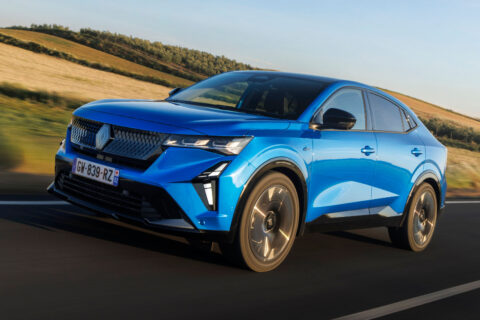The Rafale bears one of those paradoxical silhouettes that attempts to be both high-rise family hauler and rakish riviera cruiser. It mostly pulls it off to good effect. The rear seats are spacious in all dimensions (I was comfortable sitting behind a 6ft-tall driver) and the boot, while naturally incurred upon by the sloping tailgate, is flat-floored, square-sided and still usefully capacious, at 535 litres – a mere pint of milk less than in the Peugeot 408.
The most obvious trade-off for the Rafale’s slippery silhouette is rearward visibility, which takes a slight knock, but the reversing camera fills the blanks nicely, and the back seat remains a bright and airy place to be.
The cabin successfully adds a touch of upmarket appeal to an environment that’s broadly familiar from Renault’s more affordable models, introducing a slick slate-effect dash-topper and lashings of Alcantara (60% recycled, natch) and leather. But it’s a fairly dark and drab affair, all told, cheapened by the liberal use of gloss black plastic and hardly enlivened by the subtle tricolore stitching on the door panels.
Physical switchgear, comes in relative abundance, and is all of pleasing tactility and accessibility. The thick-rimmed steering wheel – gratuitously squared off though it is – hosts familiar audio and cruise control toggles for cruise control, and a panel on each side of satisfyingly responsive haptic buttons, which are each right about where you’d expect them to be.
Continuing a recent run of getting things right when it comes to ADAS and infotainment, Renault hasn’t given the Rafale’s touchscreen too much to do. The climate control is adjusted easily using a row of toggle switches and there’s a button to the side of the steering wheel that activates your stored ADAS settings, doing away with the ever-distracting process of deactivating all the legally mandated ‘assistance’ features on the move.
The screen itself is crisp of definition and its interfaces logically arranged, so it’s quick to get the hang of and easy to use on the move. It’s big, at 12in, but angled and positioned so as not to incur on your field of vision; and because it’s portrait-oriented, rather than landscape, you don’t have to stretch to reach over to the other side of the car at 70mph to change the radio channel.
It forms part of a wraparound cockpit arrangement, together with a 12.3in digital driver’s display and head-up projection that helps to create a cocooning and genuinely driver-focused environment.
That’s augmented by the bespoke seats, which have greater lateral support than those in the Austral to (ahem) bolster its sporting pretences and make the Rafale feel a touch more special than its school-running siblings.
